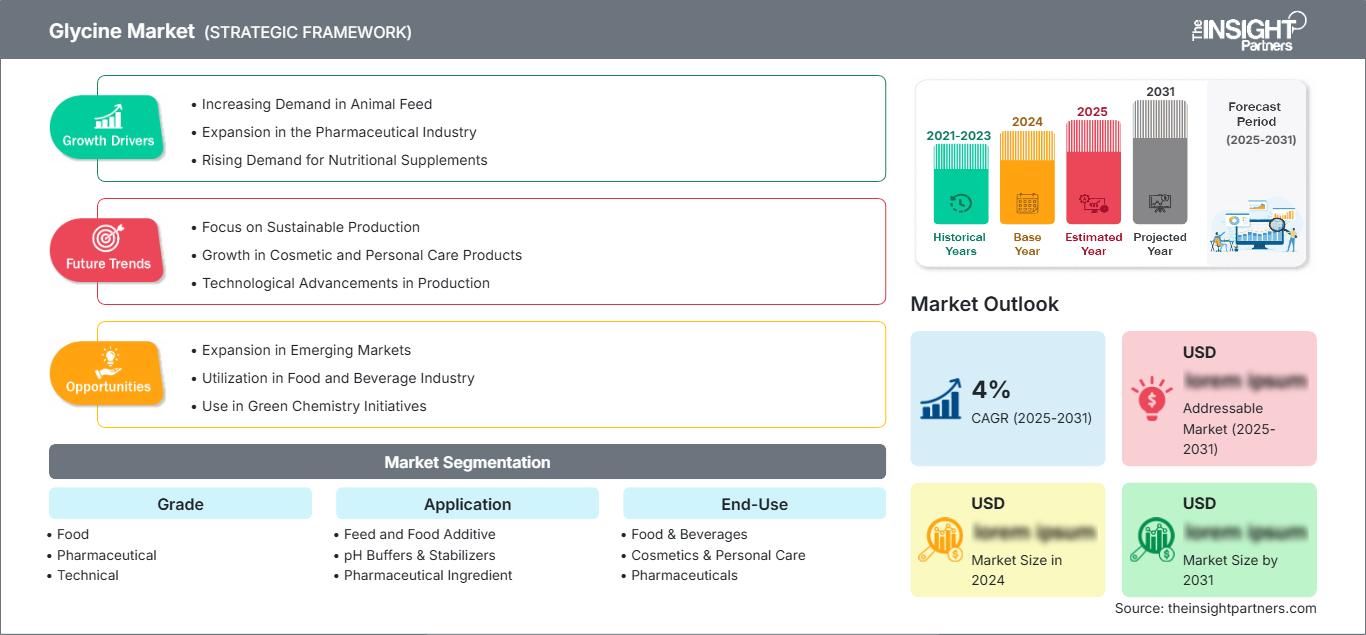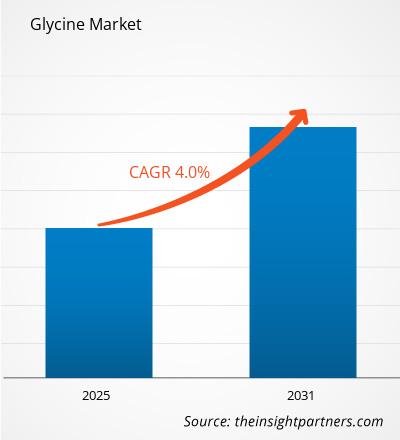Se prevé que el mercado de la glicina registre una tasa de crecimiento anual compuesta (CAGR) del 4% entre 2025 y 2031, con un tamaño de mercado que se expandirá de XX millones de dólares estadounidenses en 2024 a XX millones de dólares estadounidenses en 2031.
El informe se divide por grado (alimentario, farmacéutico y técnico). Además, presenta un análisis basado en la aplicación (aditivos para piensos y alimentos, reguladores y estabilizadores de pH, ingredientes farmacéuticos, productos químicos intermedios y otros). Según el uso final, el informe se divide en (alimentos y bebidas, cosméticos y cuidado personal, productos farmacéuticos, productos químicos intermedios y otros). El análisis global se desglosa a nivel regional y por países principales. El informe ofrece el valor en USD para los análisis y segmentos mencionados.
Propósito del Informe
El informe sobre el mercado de la glicina, elaborado por The Insight Partners, tiene como objetivo describir el panorama actual y el crecimiento futuro, los principales factores impulsores, los desafíos y las oportunidades. Esto proporcionará información valiosa a diversos actores del sector, tales como:
- Proveedores/fabricantes de tecnología: Para comprender la evolución de la dinámica del mercado y conocer las posibles oportunidades de crecimiento, lo que les permitirá tomar decisiones estratégicas informadas.
- Inversores: Realizar un análisis exhaustivo de las tendencias relativas a la tasa de crecimiento del mercado, las proyecciones financieras del mercado y las oportunidades que existen a lo largo de la cadena de valor.
- Organismos reguladores: Regular las políticas y controlar las actividades en el mercado con el objetivo de minimizar los abusos, preservar la confianza de los inversores y mantener la integridad y la estabilidad del mercado.
Segmentación del mercado de glicina
Calificación
- Alimento
- Farmacéutico
- Técnico
Solicitud
- Aditivos para piensos y alimentos
- Tampones y estabilizadores de pH
- Ingrediente farmacéutico
- Intermedio químico
uso final
- Alimentos y bebidas
- Cosméticos y cuidado personal
- Productos farmacéuticos
- Intermedio químico
Geografía
- América del norte
- Europa
- Asia-Pacífico
- América del Sur y Central
- Oriente Medio y África
Obtendrá personalización en cualquier informe, sin cargo, incluidas partes de este informe o análisis a nivel de país, paquete de datos de Excel, así como también grandes ofertas y descuentos para empresas emergentes y universidades.
Mercado de la glicina: Perspectivas estratégicas

- Obtenga las principales tendencias clave del mercado que se describen en este informe.Esta muestra GRATUITA incluirá análisis de datos, que abarcarán desde tendencias de mercado hasta estimaciones y pronósticos.
Factores que impulsan el crecimiento del mercado de la glicina
- Aumento de la demanda en la alimentación animal: El mercado de la glicina está impulsado por su creciente uso en la alimentación animal, especialmente en aves de corral y ganado. La glicina se utiliza como suplemento de aminoácidos para mejorar la salud y el crecimiento animal. A medida que aumenta el consumo mundial de carne y el sector agrícola busca optimizar las formulaciones de piensos para lograr una mayor productividad, la demanda de glicina en la nutrición animal sigue creciendo, impulsando así el mercado.
- Expansión en la industria farmacéutica: La glicina se utiliza ampliamente en la industria farmacéutica para la formulación de medicamentos y como estabilizador en vacunas. Su papel en diversas aplicaciones médicas, incluyendo su uso como ingrediente en soluciones intravenosas, ha impulsado la demanda. A medida que el sector sanitario continúa expandiéndose a nivel mundial, se prevé que la necesidad de glicina en aplicaciones farmacéuticas siga creciendo, lo que favorecerá el crecimiento del mercado.
- Aumento de la demanda de suplementos nutricionales: La glicina es un ingrediente clave en los suplementos dietéticos debido a sus efectos beneficiosos sobre el metabolismo, el sueño y la salud articular. Con una mayor concienciación de los consumidores sobre la salud y el bienestar, la demanda de suplementos a base de glicina está en auge. La creciente preferencia por los aminoácidos en alimentos funcionales y suplementos contribuye significativamente al crecimiento del mercado de la glicina.
Tendencias futuras del mercado de la glicina
- Enfoque en la producción sostenible: A medida que la demanda de glicina sigue aumentando, se prevé que los métodos de producción sostenibles y ecológicos ganen terreno. Los fabricantes están explorando procesos de producción de base biológica para reducir el impacto ambiental de la fabricación de glicina. Esta tendencia responde a las crecientes exigencias de los consumidores y de las autoridades reguladoras en materia de producción química más ecológica y sostenible, lo que definirá el futuro del mercado de la glicina.
- Crecimiento en productos cosméticos y de cuidado personal: Se prevé un aumento en el uso de la glicina en formulaciones cosméticas, especialmente para el cuidado de la piel y el cabello. Su inclusión es cada vez mayor por sus propiedades hidratantes y antienvejecimiento. Dado que la industria de la belleza se centra cada vez más en los ingredientes naturales, se anticipa que la incorporación de la glicina en productos orgánicos y sostenibles para el cuidado de la piel será una tendencia clave en el futuro, impulsando aún más la expansión del mercado.
- Avances tecnológicos en la producción: Se prevé que los avances tecnológicos en los procesos de producción de glicina aumenten la eficiencia y la rentabilidad de la fabricación. Es probable que las innovaciones, como los métodos de producción enzimáticos y basados en fermentación, predominen, mejorando el rendimiento y la sostenibilidad. A medida que la producción se vuelva más eficiente, el mercado de la glicina experimentará una mayor rentabilidad y accesibilidad, impulsando así su expansión.
Oportunidades de mercado de la glicina
- Expansión en mercados emergentes: Las economías emergentes, en particular las de Asia-Pacífico y América Latina, ofrecen importantes oportunidades para el mercado de la glicina. La creciente demanda de piensos, productos sanitarios y suplementos nutricionales en estas regiones impulsará el crecimiento del mercado. Las empresas pueden explorar estos mercados sin explotar mediante la introducción de productos asequibles a base de glicina y la ampliación de su capacidad de producción en estas regiones.
- Utilización en la industria de alimentos y bebidas: El potencial de la glicina como aditivo alimentario, en particular por su capacidad para realzar sabores y estabilizar formulaciones, representa una oportunidad de crecimiento en el sector de alimentos y bebidas. A medida que las preferencias de los consumidores se orientan hacia opciones de alimentos más saludables y funcionales, la demanda de glicina en alimentos y bebidas seguirá aumentando, lo que abrirá nuevas vías para el desarrollo del mercado.
- Uso en iniciativas de química verde: Las aplicaciones de la glicina en la química verde, particularmente en la síntesis química sostenible y la biocatálisis, ofrecen oportunidades para el crecimiento futuro del mercado. A medida que las industrias adoptan cada vez más prácticas respetuosas con el medio ambiente, el papel de la glicina como producto químico sostenible en diversos procesos podría brindar a los fabricantes una ventaja competitiva, permitiéndoles atender a las industrias con conciencia ecológica que buscan alternativas más sostenibles.
Perspectivas regionales del mercado de la glicina
Los analistas de The Insight Partners han explicado detalladamente las tendencias regionales y los factores que influyen en el mercado de la glicina durante el período de previsión. Esta sección también analiza los segmentos del mercado de la glicina y su distribución geográfica en Norteamérica, Europa, Asia Pacífico, Oriente Medio y África, y Sudamérica y Centroamérica.
Alcance del informe de mercado de glicina
| Atributo del informe | Detalles |
|---|---|
| Tamaño del mercado en 2024 | XX millones de dólares estadounidenses |
| Tamaño del mercado para 2031 | XX millones de dólares estadounidenses |
| Tasa de crecimiento anual compuesto global (2025 - 2031) | 4% |
| Datos históricos | 2021-2023 |
| período de previsión | 2025-2031 |
| Segmentos cubiertos | Por grado
|
| Regiones y países cubiertos | América del norte
|
| Líderes del mercado y perfiles de empresas clave |
|
Densidad de los actores del mercado de la glicina: comprensión de su impacto en la dinámica empresarial
El mercado de la glicina está creciendo rápidamente, impulsado por la creciente demanda de los usuarios finales debido a factores como la evolución de las preferencias de los consumidores, los avances tecnológicos y una mayor conciencia de los beneficios del producto. A medida que aumenta la demanda, las empresas amplían su oferta, innovan para satisfacer las necesidades de los consumidores y aprovechan las nuevas tendencias, lo que impulsa aún más el crecimiento del mercado.

- Obtenga una visión general de los principales actores del mercado de la glicina
Puntos clave de venta
- Cobertura integral: El informe abarca de forma exhaustiva el análisis de productos, servicios, tipos y usuarios finales del mercado de la glicina, proporcionando una visión holística.
- Análisis de expertos: El informe se elabora a partir del profundo conocimiento de expertos y analistas del sector.
- Información actualizada: El informe garantiza su relevancia para el negocio gracias a su cobertura de información reciente y tendencias de datos.
- Opciones de personalización: Este informe se puede personalizar para satisfacer las necesidades específicas del cliente y adaptarse adecuadamente a las estrategias comerciales.
Por lo tanto, el informe de investigación sobre el mercado de la glicina puede ayudar a impulsar la comprensión del panorama de la industria y sus perspectivas de crecimiento. Si bien existen algunas preocupaciones válidas, los beneficios generales de este informe tienden a superar las desventajas.
- Análisis histórico (2 años), año base, pronóstico (7 años) con CAGR
- Análisis PEST y FODA
- Tamaño del mercado, valor/volumen: global, regional y nacional
- Industria y panorama competitivo
- Conjunto de datos de Excel
Informes recientes
Testimonios
Razón para comprar
- Toma de decisiones informada
- Comprensión de la dinámica del mercado
- Análisis competitivo
- Información sobre clientes
- Pronósticos del mercado
- Mitigación de riesgos
- Planificación estratégica
- Justificación de la inversión
- Identificación de mercados emergentes
- Mejora de las estrategias de marketing
- Impulso de la eficiencia operativa
- Alineación con las tendencias regulatorias




















 Obtenga una muestra gratuita para - Mercado de glicina
Obtenga una muestra gratuita para - Mercado de glicina